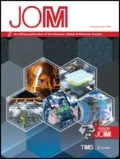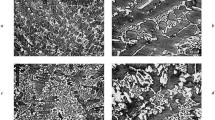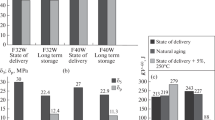Abstract
The principles of strain aging are described in terms of the Cottrell theory. It is deduced that the practical control of strain aging must come through control of the effective amounts of carbon and nitrogen in solution. Existing control methods such as precipitation through alloying or heat treatment are reviewed and their deficiencies described. Experimental results for a series of alloys containing carbon and nitrogen show that only carbon strain aging can be eliminated by heat treatment. The use of titanium, aluminum, vanadium, and boron as alloying elements for the control of nitrogen strain aging is examined. All of these elements are effective but for economic reasons boron additions appear to offer the most promising practical solution to the problem of nitrogen strain aging in steels.
Similar content being viewed by others
References
A.H. Cottrell: Effect of Solute Atoms on the Behaviour of Dislocations. Report of a Conference on Strength of Solids, The Physical Soc., 1948, pp. 30–38.
A. Hayes and R. O. Griffis: Nonaging Iron and Steel for Deep Drawing. Metals and Alloys, 1934, vol. 5, pp. 110–112.
C. A. Edwards, D. L. Phillips, and H. N. Jones: The Influence of Some Special Elements upon the Strain Aging and Yield Point Characteristics of Carbon Steels. Journal Iron and Steel Inst., 1940, vol. 142, pp. 199–236.
A. H. Cottrell and G. M. Leak: Effect of Quench Aging on Strain Aging in Iron. Journal Iron and Steel Inst., 1952, vol. 172, pp. 301–306.
J. D. Fast and L. J. Dijkstra: Internal Friction in Iron and Steel. Philips Technical Review, 1951, vol. 13, pp. 172–179.
S. Epstein: U. S. Patent No. 2,356,450. 1944.
S. Epstein, H. J. Cutler, and J. W. Frame: Vanadium Treated, Non-Aging, Rimmed Steel for Deep Drawing Quality Sheet. AIME Trans., 1950, vol. 188, pp. 830–834; Journal of Metals, June 1950.
G. E. Speight: Discussion to a paper by W. E. Bardgett and L. Reeve. Journal Iron and Steel Inst., 1950, vol. 166, pp. 196–198.
J. C. Shyne and E. R. Morgan: The Effect of Nitrogen on Hardenability of Boron Steels. AIME Trans., 1957, vol. 209, pp. 116–117; Journal of Metals, January 1957.
G. Derge: The Boron-Oxygen Equilibrium in Liquid Iron. AIME Trans., 1946, vol. 167, pp. 93–110; Metals Technology, August 1946.
W. C. Leslie and R. L. Rickett: Influence of Aluminum and Silicon Deoxidation on the Strain Aging of Low Carbon Steels. AIME Trans., 1953, vol. 197, pp. 1021–1031; Journal of Metals, August 1953.
W. R. D. Jones and G. Coombes: Strain Aging of Mild Steel. Journal Iron and Steel Inst., 1953, vol. 174, pp. 9–15.
J. D. Fast: Strain Aging in Iron and Steel. Philips Technical Review, 1952, vol. 14, pp. 60–67.
C. A. Wert: Precipitation from Solid Solutions of Carbon and Nitrogen in Alpha-Iron. Journal of Applied Physics, 1949, vol. 20, pp. 943–949.
Author information
Authors and Affiliations
Additional information
TP 4382E. Manuscript,. Apr. 16, 1956. Cleveland Meeting, October 1956.
Rights and permissions
About this article
Cite this article
Morgan, E.R., Shyne, J.C. Control of strain aging in alpha-iron. JOM 9, 65–69 (1957). https://doi.org/10.1007/BF03398454
Published:
Issue Date:
DOI: https://doi.org/10.1007/BF03398454




